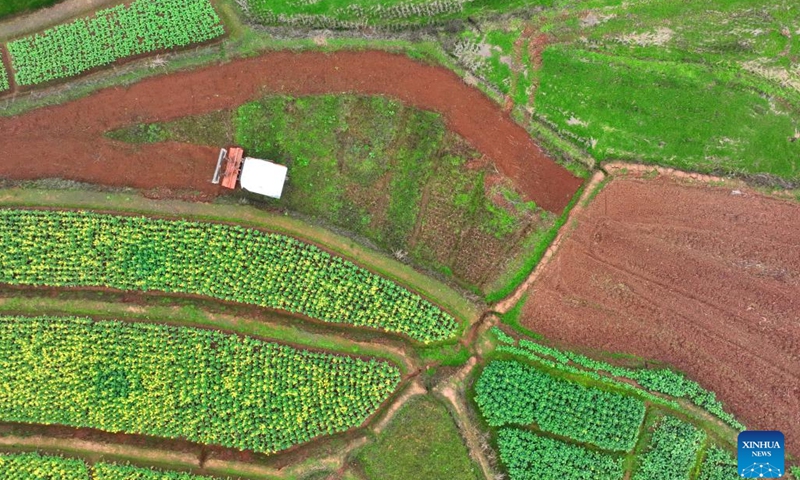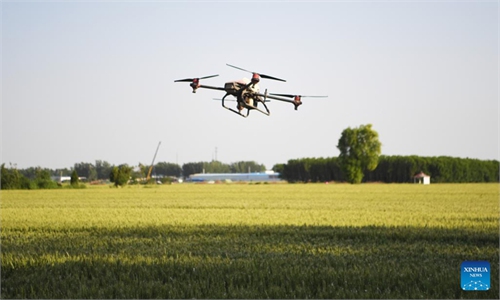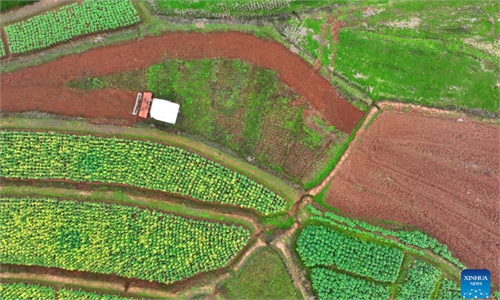Nation gears up for early spring plowing, making good start in shoring up food security

This aerial photo taken on Feb. 19, 2023 shows a farmer driving an agricultural machinery to plow the field in Qidong County in Hengyang, central China's Hunan Province. In early spring, as temperatures gradually rise, farmers across the country are actively engaged in spring ploughing and preparations for farming activities.(Photo: Xinhua)
Farmers across China are ramping up for spring plowing with the preparation for fertilizers and other materials in place, while trying to expand planting area in order to shore up the country's food security.
Spring plowing has been carried out, from South China's Guangxi Zhuang Autonomous Region to North China's Hebei Province with the wide adoption of mechanization, industry insiders said.
In Guigang's Gangbei district, Guangxi Zhuang Autonomous Region, a major food production area, farmers have prescheduled plowing for the season.
Ji Mengjia, the head of a farming cooperative in Gangbei, told the Global Times on Sunday that the organization has achieved more than 80 percent mechanization rate in farming, which enables efficient operation from plowing to harvesting.
For example, fertilizing will be conducted via drones now. Automation is widely adopted in raising seeds, which reduces production costs and secures seeds quality, Ji said.
Farmers in Gangbei district are raising 400-500 mu (27-33 hectares) of seedlings per day, and 40,000-50,000 mu of seedlings are expected to be raised, which would double the area last year.
Some 625 irrigation areas in 12 provinces have been under operation, involving water diversion of more than 2.5 billion cubic meters and covering 1.42 million hectares of planting fields, data from the Ministry of Water Resources showed.
Fertilizers have been distributed and are ready for use in nearly 70 percent of the provinces nationwide, ahead of schedule, according to media reports.
Yongfeng village in Meishan, Southwest China's Sichuan Province, is upgrading farmland for spring plowing as well as improving land utilization for higher production, the Global Times learned from Liu Chao, the head of the village, on Sunday.
It is raising seeds in preparation for the full start of spring plowing in April. As a signature village for farming, it is fully automated. With the improvement of land utilization and active preparation for spring plowing, it is expected to expand grain production land to nearly 6,000 mu from 5,760 mu last year, which is also part of the effort to guard food security under the government's call, Liu said.
In Handan, Hebei Province, a specially designed irrigation machine has been adopted as part of the improvement in mechanization in the region.
Wang Feipeng, a local farmer, told the media that it improves plowing efficiency and also saves at least 50 percent of the water per mu and reduces other costs by 100 yuan ($14.48) per mu.
China's agricultural production capacity has increased significantly in the past five years. One highlight is the comprehensive mechanization rate of crop cultivation and harvesting rose from 67 percent five years ago to 73 percent today.
The good preparation for spring plowing marks the government's consistent efforts in putting food security at the top of the agenda, exemplified by breakthroughs from production to mechanization.
For eight consecutive years, China's total annual grain output has remained above 1.3 trillion jin (650 billion kilograms), effectively responding to the impact of the changing world situation and the COVID pandemic, Zhong Yu, an expert with the Institute of Agricultural Economics and Development, Chinese Academy of Agricultural Sciences, told the Global Times on Sunday.
The comprehensive mechanization rates of wheat, corn and rice, the three major food crops in China, range from 85 percent for rice to 97 percent for wheat, according to Zhong.
Zhong said that China's grain output per capita has reached 483 kilograms, which is higher than the internationally recognized 400-kilogram grain security line.
This year, China will add 45 million mu (3 million hectares) of high-standard farmland and upgrade 35 million mu of farmland.
To achieve this goal, more efforts are to be made in strengthening food production, experts said, including providing more subsidies for farmers and improving the compensation mechanism for securing the interests of the main production areas.


